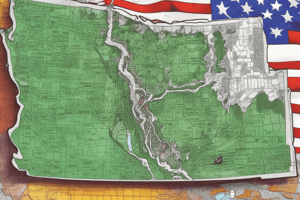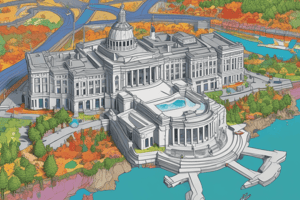Podcast
Questions and Answers
What is the primary legal requirement that necessitates redistricting?
What is the primary legal requirement that necessitates redistricting?
- Population changes recorded every ten years. (correct)
- Changes in campaign finance laws.
- Federal mandates on voting rights.
- A shift in the political climate.
What is the term used to describe the practice of drawing electoral districts to benefit the party in power?
What is the term used to describe the practice of drawing electoral districts to benefit the party in power?
- Gerrymandering (correct)
- Franchising
- Suffrage
- Apportionment
Following the redistricting process after the 2020 census, what immediate legal action was taken?
Following the redistricting process after the 2020 census, what immediate legal action was taken?
- The Governor immediately approved the new districts.
- Criminal investigations were launched.
- Lawsuits were filed against the new districts. (correct)
- A federal investigation by the Department of Justice was initiated.
In the context of Texas elections, what characterizes a 'closed primary'?
In the context of Texas elections, what characterizes a 'closed primary'?
What typically occurs in a general election in Texas?
What typically occurs in a general election in Texas?
What is a characteristic of special elections in Texas that often influences the outcome?
What is a characteristic of special elections in Texas that often influences the outcome?
How does straight-ticket voting potentially impact elections?
How does straight-ticket voting potentially impact elections?
What was the primary focus of Senate Bill 1, passed in Texas, concerning absentee ballots?
What was the primary focus of Senate Bill 1, passed in Texas, concerning absentee ballots?
How do election cycles in Texas relate to campaign contributions?
How do election cycles in Texas relate to campaign contributions?
What was the main purpose of Jim Crow laws in Texas?
What was the main purpose of Jim Crow laws in Texas?
What is the difference between retrospective and prospective judgment in the context of elections?
What is the difference between retrospective and prospective judgment in the context of elections?
How did Texas's requirement for property ownership affect voting rights?
How did Texas's requirement for property ownership affect voting rights?
What role did the 'White Primary' play in Texas elections?
What role did the 'White Primary' play in Texas elections?
How did Texas's actions relate to the Voting Rights Act between 1982 and 2006?
How did Texas's actions relate to the Voting Rights Act between 1982 and 2006?
What was the significance of 'separate but equal' treatment in post-Civil War Texas?
What was the significance of 'separate but equal' treatment in post-Civil War Texas?
How is eligibility to vote determined in Texas?
How is eligibility to vote determined in Texas?
What was the primary aim of the Voting Rights Act of 1965?
What was the primary aim of the Voting Rights Act of 1965?
What is the significance of Section 5 concerning Texas's ballot access in 1975?
What is the significance of Section 5 concerning Texas's ballot access in 1975?
How did SB 1 potentially impact voting rights in Texas?
How did SB 1 potentially impact voting rights in Texas?
What is the 'suffrage'?
What is the 'suffrage'?
What was the main goal of the Texas Woman Suffrage Resolution?
What was the main goal of the Texas Woman Suffrage Resolution?
What was the significance of the 19th Amendment to the U.S. Constitution?
What was the significance of the 19th Amendment to the U.S. Constitution?
Why are states required to redraw congressional districts every ten years according to the U.S. Constitution?
Why are states required to redraw congressional districts every ten years according to the U.S. Constitution?
Which of the following best describes the impact of the Civil Rights Act of 1964 on voting rights?
Which of the following best describes the impact of the Civil Rights Act of 1964 on voting rights?
Flashcards
Democracy
Democracy
A form of collective governance where eligible citizens participate in selecting their representatives.
Retrospective judgment
Retrospective judgment
Evaluating an incumbent's past performance to decide whether to re-elect them.
Prospective judgment
Prospective judgment
Evaluating what candidates pledge to do in the future if elected.
Election cycles
Election cycles
Signup and view all the flashcards
Campaign contributions
Campaign contributions
Signup and view all the flashcards
Eligibility to vote in Texas
Eligibility to vote in Texas
Signup and view all the flashcards
Jim Crow Laws
Jim Crow Laws
Signup and view all the flashcards
The White Primary
The White Primary
Signup and view all the flashcards
Section 5 of the Voting Rights Act
Section 5 of the Voting Rights Act
Signup and view all the flashcards
Suffrage
Suffrage
Signup and view all the flashcards
Women's Suffrage Movement
Women's Suffrage Movement
Signup and view all the flashcards
19th Amendment
19th Amendment
Signup and view all the flashcards
Civil Rights Act of 1964
Civil Rights Act of 1964
Signup and view all the flashcards
Voting Rights Act of 1965
Voting Rights Act of 1965
Signup and view all the flashcards
Redistricting
Redistricting
Signup and view all the flashcards
U.S. Constitution & Redistricting
U.S. Constitution & Redistricting
Signup and view all the flashcards
Gerrymandering
Gerrymandering
Signup and view all the flashcards
Primary Election
Primary Election
Signup and view all the flashcards
Closed Primary
Closed Primary
Signup and view all the flashcards
Open Primary
Open Primary
Signup and view all the flashcards
General Election
General Election
Signup and view all the flashcards
Special Elections
Special Elections
Signup and view all the flashcards
Split-Ticket Voting
Split-Ticket Voting
Signup and view all the flashcards
Study Notes
- The role of voting is central to democracy and collective governance.
- Debates about electoral issues have been ongoing since the country's founding.
- Representative governments have become the norm.
- Elections are critical in society for retrospective and prospective judgment.
- Election cycles and campaign contributions follow a set calendar.
- Each state determines its own election processes.
- Laws determine which candidates receive contributions.
- There are specific election periods.
- Campaign donations play a role in elections.
- Eligibility to vote in Texas is determined by voter requirements in the state constitution.
- Voter registration and voter ID are required to vote in Texas.
- Voter disenfranchisement has historical roots in Texas
- Maintaining white social order was the aim post-Civil War.
- "Separate but equal" treatment.
- White Texans worked to entrench electoral rights.
Jim Crow Laws
- Racial segregation was imposed.
- The system was upheld by local officials.
- Laws limited interracial coalitions.
- Poll taxes were implemented.
The White Primary
- Known as "The White Man's Union Associations.”
- Defined as white primaries.
- Texas prevailed in various lawsuits related to this.
- Texas used to require owning property to vote.
- Owning property was later required to vote in bond elections.
- There was a history of resolute disenfranchisement of Black people.
- The Voting Rights Act was introduced.
- From 1982-2006, Texas led in violating Sections 5 and 2 of the Voting Rights Act.
- In 1975, Texas became subject to Section 5 of the Voting Rights Act.
- It took years for Texas to comply with bilingual ballot provisions.
- Texans with disabilities face obstacles to voting.
- SB 1 legislation further restricts voting rights for those with disabilities.
Legislation to Ease Voting
- Implemented motor voter registration.
- The Federal MOVE Act of 2009 was passed.
- The Help America Vote Act (HAVA) was enacted.
- Suffrage is defined as the right to vote in an election.
Women's Suffrage Movement
- The movement was a decades-long national fight.
- Early efforts were directed toward suffrage.
- The Texas Woman Suffrage Resolution was created.
- The 19th Amendment was passed.
- There was a Women-Only Supreme Court case, W. T. Johnson et al. v. J. M. Darr, et al.
- Miriam A. Ferguson and Wallace B. Jefferson were involved in the movement.
- Equal rights and the women's movement continue today.
- Black women were active in women's suffrage.
- Women's right to vote was recognized in the 1950s.
Civil Rights Movement
- The movement involved protests, demonstrations, and boycotts.
- The Civil Rights Act of 1964 was passed.
- The Voting Rights Act of 1965 was passed.
- The U.S. Constitution requires states to redraw congressional districts every ten years.
- Texas mandates redistricting of house and senate seats.
- Multiple types of districts exist.
- Redistricting is legally required to draw electoral districts which must happen every ten years.
- Redistricting is controlled by the party in power.
- The intent of the redistricting process is relevant.
- Gerrymandering is a part of redistricting.
- New political districts were drawn in 2020.
- Lawsuits were brought against the new districts.
- Civil rights groups sued Republican lawmakers over redistricting.
- In May 2022, the Supreme Court denied an emergency request related to redistricting.
Texas Elections
- Utilizes closed primary, open primary, and crossover voting systems.
- Each state schedules its own primaries.
- A general election involves competition between two parties' nominees.
- Local- and state-level elections are held.
- Special elections are held for many purposes.
- Texas dispenses with party primaries in special elections.
- Special elections often have Low turnout with a more conservative electorate.
- Straight ticket voting involves selecting one party's complete slate of candidates.
- That contributes to one-party dominance.
- Split-ticket voting involves splitting votes from different parties.
- Used by both Republicans and Democrats.
- Absentee requirements are strict.
- There are specific requirements for absentee ballots.
- Limitations on absentee ballots were unchanged even during the pandemic.
- There were reductions in ballot drop-off locations.
- In 2020, the Texas Democratic Party filed a federal lawsuit regarding absentee ballots.
- In 2021, Senate Bill 7 was introduced.
- Texas later passed Senate Bill 1.
- Voter registration surged throughout Texas prior to the 2020 election.
- 66% of registered voters cast ballots in 2020.
- Paxton was involved with the voting and electoral college.
- January 6, 2021, saw Paxton at the Capitol building attack.
- The Texas government rejects calls for online voter registration.
- In 2020, Texas was forced to provide it.
Online Voter Registration
- Supply chain issues arose.
- Online voter registration was seen as a solution.
- There are proposals to expand voting.
- Efforts are aimed to ensure non-purging of eligible voters.
- Ranked-choice voting (RCV) is another proposed electoral reform.
Studying That Suits You
Use AI to generate personalized quizzes and flashcards to suit your learning preferences.
Related Documents
Description
Explore redistricting legal requirements and gerrymandering practices. Understand the legal actions following the 2020 census redistricting. Learn about closed primaries, general elections, and special elections in Texas and their influence on voting outcomes.




